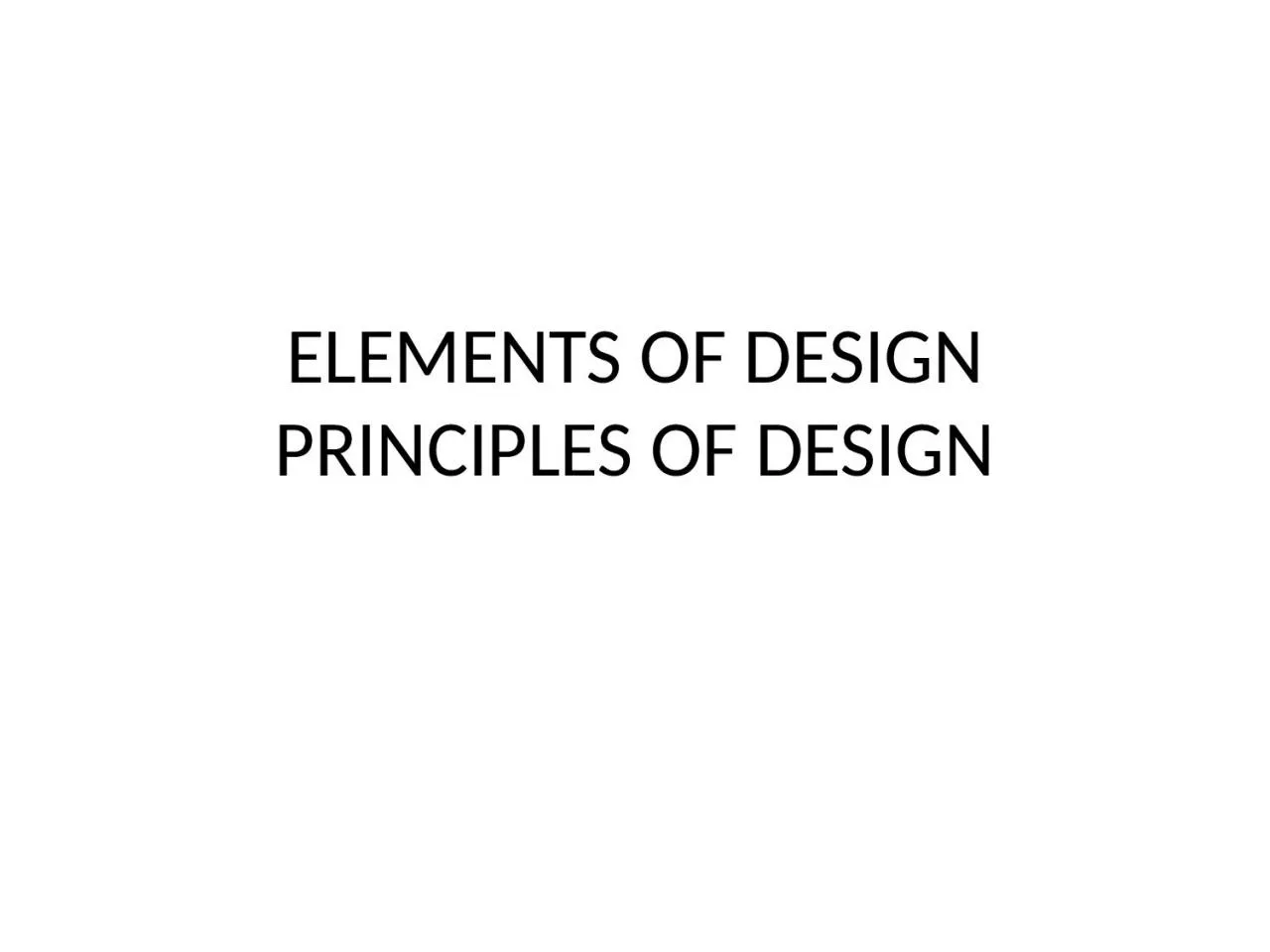

ELEMENTS OF DESIGN Day1 Elements of Design In creating a design one of the components which interact is the Art Elements The elements and principles of design are flexible and should be interpreted within the context of current fashion A design can be defined as an arrangement of lines sha ID: 1014646
Download Presentation The PPT/PDF document "ELEMENTS OF DESIGN PRINCIPLES OF DESIGN" is the property of its rightful owner. Permission is granted to download and print the materials on this web site for personal, non-commercial use only, and to display it on your personal computer provided you do not modify the materials and that you retain all copyright notices contained in the materials. By downloading content from our website, you accept the terms of this agreement.
1. ELEMENTS OF DESIGNPRINCIPLES OF DESIGN
2. ELEMENTS OF DESIGNDay.1 Elements of Design:In creating a design one of the components which interact is the Art Elements The elements and principles of design are flexible and should be interpreted within the context of current fashion. A design can be defined as an arrangement of lines, shape, colors and texture that create a visual image. The principles of design are the rates that govern how elements are combined. The elements are therefore the raw materials that must be combined successfully.The following are the different elements of Design:LineFormShapeTexture andColor
3. ELEMENTS OF DESIGN
4. ELEMENTS OF DESIGN1.LINEDay.2Line:It provides the visual dimensions of length and width. When lines combine, space is enclosed and forms and shapes are defined. Lines offered a path of vision for the eyes when is wearing an object/outfit. The arrangement of lines in clothing design can cause to appear heavier or thinner than what actually isHorizontal lineVertical lineOblique lineDiagonal line.Curved line etc.
5. LINE
6. ELEMENTS OF DESIGN 2.FORMDay.3Form:It is an object having three dimensions like length, width and depth. The human body is a form and by viewing it analytically, its various perspectives are revealed. The human form changes visually with clothing, especially as fashion changes.
7. FORM
8. ELEMENTS OF DESIGN4.SHAPESDay.4SHAPES:It describes the outer dimensions or contour of an object. Shape also encloses space and imparts a certain character to the object viewed. Through clothing design, the shape of the human body is often revealed in a natural way, but sometimes even distorted. The shape of clothing in a human body, communicates silently, the messages about the wearer.
9. SHAPES
10. Day.5Color:When we talk of principles of designing, or when we start off with a given design theme the first thing to occur to our minds is the co lour and texture of the fabricELEMENTS OF DESIGN5.COLOUR
11. COLOUR
12. ELEMENTS OF DESIGN6.TEXTUREDay.6Texture:As texture is the feel, drape and degree of stiffens and softness of the fabric, it also creates a visual effect upon the wearer, given a small swatch of fabric, the designer can visualize the texture and the fall of fabric which helps him to design further.
13. TEXTURE
14. PRINCIPLES OF DESIGNDay.7The Principles of Fashion Design:The Principles are concepts used to organize or arrange the structural elements of design. Principles are guidelines and fundamental ideas that every designer in the working field should follow. In fashion design, there are five important principles and then apply to both the garments basic structure and that application. They provide guidelines to combine properly the five elements of design to create BalanceProportionEmphasisRhythmHarmony
15. PRINCIPLES OF DESIGN 1.BALANCEDay.7Balance is the concept of visual equilibrium and relates to our physical sense of balance. It is a reconciliation of opposing forces in a composition that results in visual stability. Balance relates to the overall stability in the dress with the satisfactory arrangement of parts and details. Well, balanced dress produces visual harmony. The balanced design of the fashion is also divided into two ways. Such as-Symmetric BalanceAsymmetric Balance
16. BALANCE
17. PRINCIPLES OF DESIGNS2.RHYTHMDay.8Rhythm is created when one or more elements of design are used repeatedly to create a feeling of organized movement. Rhythm creates a mood like music or dancing. To keep rhythm exciting and active, variety is essential.
18. RHYTHM
19. PRINCIPLES OF DESIGN3.EMPHASISDay.93. Emphasis or Centre of Attraction:Emphasis is the concentrations of interest in the selected area of design. Usually, designers will make one area stand out by contrasting it with other areas. The area could be different in size, color, texture, shape.
20. PRINCIPLES OF DESIGN4.HARMONYDay.105. Harmony or Unity:It is also called as UNITY of design. A good balance between unity and variety must be established to avoid a chaotic or a lifeless design. Unity is the feeling of harmony between all parts of the work of art, which creates a sense of completeness. Unity is a difficult principle to define. Unity ensures the goal for the overall look.
21. PRINCIPLES OF DESIGN5.PROPORTIONDay.112. Proportion:Proportion is the feeling of unity created when all parts (sizes, amounts, or number) relate well with each other. When drawing the human figure, the proportion can refer to the size of the head compared to the rest of the body.
22. PROPORTION